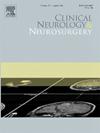Unilateral biportal endoscopic discectomy for lumbar disc herniation: Learning curve analysis with CUSUM analysis and clinical outcomes
IF 1.8
4区 医学
Q3 CLINICAL NEUROLOGY
引用次数: 0
Abstract
Background
The evolution of spinal surgery has significantly benefited from advances in medical technology. From the introduction of the microscope to spinal surgery by Gazi Yaşargil in 1967 to Kambin's fully endoscopic series in the late 20th century, minimally invasive techniques have continually evolved. One of the latest developments, Unilateral Biportal Endoscopy (UBE), has gained popularity due to its effectiveness and the use of standard arthroscopic instruments, facilitating anatomical orientation for surgeons familiar with microsurgery. Despite its advantages, UBE presents challenges during the learning phase, necessitating a thorough understanding of its learning curve. This study aims to evaluate the learning curve of unilateral biportal endoscopic (UBE) discectomy for the treatment of lumbar disc herniation using CUSUM and risk-adjusted CUSUM (RA-CUSUM) analyses and to share the challenges encountered in the learning process and clinical outcomes.
Method
This retrospective study is based on data from patients treated between March 2022 and March 2023. The study included patients with lumbar disc herniation treated via UBE, excluding those with other spinal conditions or previous endoscopic fusions. Data collected included demographics, surgical details, and clinical outcomes, such as VAS, ODI scores, complication rate, recurrence rate, and MacNab criteria.
Results
117 patients (126 levels) were included, with a mean age of 46.02 years and a male predominance (62 %). The mean operation time was 77.93 minutes, with significant postoperative improvements in VAS and ODI scores. The overall complication rate was 10.3 %, with a recurrence rate of 5.1 %. CUSUM analysis indicated that the learning curve for UBE was completed after 43 cases, while RA-CUSUM suggested proficiency after 23 cases.
Conclusion
UBE discectomy is an effective minimally invasive technique with a learning curve. Using CUSUM and RA-CUSUM analyses, our study provides insights into the learning process and highlights the need for gradual case selection and surgical considerations to achieve proficiency. This technique is considered a promising alternative for surgeons looking to expand their spinal surgery spectrum.
单侧双侧内窥镜椎间盘切除术治疗腰椎间盘突出症:通过 CUSUM 分析和临床结果进行学习曲线分析
本文章由计算机程序翻译,如有差异,请以英文原文为准。
求助全文
约1分钟内获得全文
求助全文
来源期刊

Clinical Neurology and Neurosurgery
医学-临床神经学
CiteScore
3.70
自引率
5.30%
发文量
358
审稿时长
46 days
期刊介绍:
Clinical Neurology and Neurosurgery is devoted to publishing papers and reports on the clinical aspects of neurology and neurosurgery. It is an international forum for papers of high scientific standard that are of interest to Neurologists and Neurosurgeons world-wide.
 求助内容:
求助内容: 应助结果提醒方式:
应助结果提醒方式:


